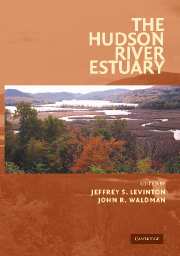Book contents
- Frontmatter
- Contents
- Preface
- List of Contributors
- The Hudson River Estuary
- 1 The Hudson River Estuary: Executive Summary
- GEOLOGICAL, PHYSICAL, AND CHEMICAL SETTING OF THE HUDSON
- PRIMARY PRODUCTION, MICROBIAL DYNAMICS, AND NUTRIENT DYNAMICS OF THE HUDSON
- HUDSON RIVER COMMUNITIES, FOOD WEBS, AND FISHERIES
- CONTAMINANTS AND MANAGEMENT ISSUES OF THE HUDSON RIVER ESTUARY
- 22 The History and Science of Managing the Hudson River
- 23 Hudson River Sewage Inputs and Impacts: Past and Present
- 24 PCBs in the Upper and Tidal Freshwater Hudson River Estuary: The Science behind the Dredging Controversy
- 25 Transport, Fate, and Bioaccumulation of PCBs in the Lower Hudson River
- 26 Contaminant Chronologies from Hudson River Sedimentary Records
- 27 Atmospheric Deposition of PCBs and PAHs to the New York/New Jersey Harbor Estuary
- 28 Toxic Substances and Their Impact on Human Health in the Hudson River Watershed
- 29 Impacts of Piers on Juvenile Fishes in the Lower Hudson River
- 30 Physiological and Genetic Aspects of Toxicity in Hudson River Species
- Index
- Plate section
- References
28 - Toxic Substances and Their Impact on Human Health in the Hudson River Watershed
Published online by Cambridge University Press: 06 January 2010
- Frontmatter
- Contents
- Preface
- List of Contributors
- The Hudson River Estuary
- 1 The Hudson River Estuary: Executive Summary
- GEOLOGICAL, PHYSICAL, AND CHEMICAL SETTING OF THE HUDSON
- PRIMARY PRODUCTION, MICROBIAL DYNAMICS, AND NUTRIENT DYNAMICS OF THE HUDSON
- HUDSON RIVER COMMUNITIES, FOOD WEBS, AND FISHERIES
- CONTAMINANTS AND MANAGEMENT ISSUES OF THE HUDSON RIVER ESTUARY
- 22 The History and Science of Managing the Hudson River
- 23 Hudson River Sewage Inputs and Impacts: Past and Present
- 24 PCBs in the Upper and Tidal Freshwater Hudson River Estuary: The Science behind the Dredging Controversy
- 25 Transport, Fate, and Bioaccumulation of PCBs in the Lower Hudson River
- 26 Contaminant Chronologies from Hudson River Sedimentary Records
- 27 Atmospheric Deposition of PCBs and PAHs to the New York/New Jersey Harbor Estuary
- 28 Toxic Substances and Their Impact on Human Health in the Hudson River Watershed
- 29 Impacts of Piers on Juvenile Fishes in the Lower Hudson River
- 30 Physiological and Genetic Aspects of Toxicity in Hudson River Species
- Index
- Plate section
- References
Summary
abstract In this chapter, we examine the impacts on human health of persistent environmental pollutants found in the watershed of the Hudson River, with particular focus on the potential of these contaminants to cause injury to the developing human brain. Polychlorinated biphenyls (PCBs), organochlorine pesticides, and mercury have been shown to be widespread in bottom sediments as well as in edible species of fish, shellfish, and crustaceans in the lower Hudson River and the New York Harbor complex. Interview surveys of anglers have documented that local residents consume fish, shellfish, and crustaceans from the lower Hudson, despite longstanding advisories by health officials. Poor people and people of color are the most likely to consume locally caught fish. In a recent pilot survey of levels of PCBs, organochlorine pesticides, and mercury in the blood and hair of local anglers, we documented that anglers who consume fish from the lower Hudson River and New York Harbor have higher levels than anglers who consume no locally caught fish. A positive exposure-response relationship was seen in these findings, with the highest levels of PCBs, pesticides, and mercury observed in those anglers who ate the most fish. Within the local fish-eating population, pregnant women and women of childbearing age are the groups at greatest risk. Intrauterine and early postnatal exposures to PCBs and mercury, at levels similar to the levels found in Hudson River aquatic species, have been shown in carefully conducted prospective epidemiological studies of human infants and children to cause loss of intelligence and alteration of behavior.
- Type
- Chapter
- Information
- The Hudson River Estuary , pp. 413 - 427Publisher: Cambridge University PressPrint publication year: 2006
References
- 1
- Cited by



